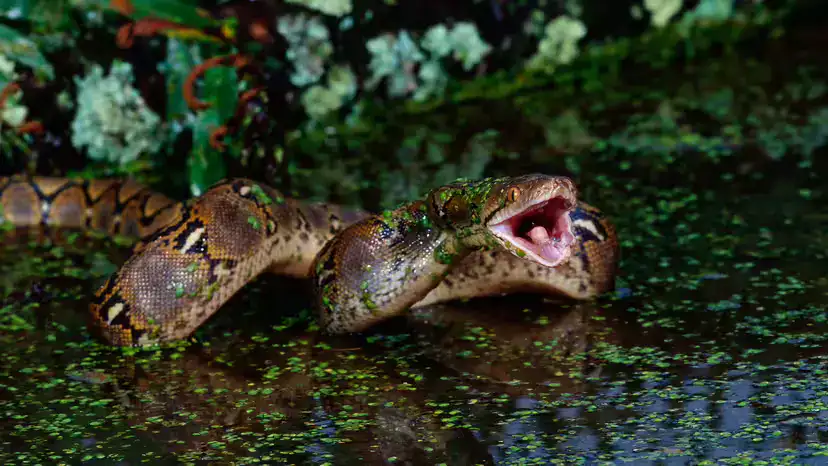Scientific name: Python reticulatus
Also called: Retic, reticulated python
Range: South & Southeast Asia (e.g., Indonesia, Philippines, Malaysia, Vietnam, Borneo, Nicobar Islands)
Typical length: 10–20 ft (3–6 m); extremes can exceed ~32 ft (~9.8 m)
Ecological role: Apex predator (mammals & birds)
Habitats: Lowland rainforest, secondary woodland, edge grassland, rice fields, riverbanks, lakes, swamps

Among the “giant snakes,” green anacondas usually win for heaviest, but reticulated pythons take the crown for longest. Wild individuals near 10 m have been reported, while most adults measure 3–6 m. This extreme length reflects efficient energy use and slow, lifelong growth.
Tip: “Biggest” can mean length, weight, or girth. Retics win on length, anacondas on mass.
Retics occupy a wide tropical belt across Southeast Asia. They’re strongly associated with water—river floodplains, oxbow lakes, marshy forest edges—and also persist in human-modified areas (canals, plantation margins, rice paddies) when cover and prey are available.
Size: Adults commonly 10–20 ft; giants >30 ft possible.
Pattern: Complex black–yellow–brown reticulated “chain/diamond” network—excellent camouflage.
Build: Long, muscular, streamlined; strong swimmer.
Head: Triangular, clearly distinct from the neck.
Pupils: Vertical slits—well adapted to low light.
Teeth: Numerous rear-curved needles to hook and hold prey for the coils.
Jaws: Highly flexible; left/right lower jaws not rigidly fused, allowing massive gape.
Heat pits: Infrared-sensing pits along upper and lower jaws for detecting warm-blooded prey.
Scales: Small, smooth—reduces drag in water and shrubs.
Vestigial spurs: Small “claw-like” remnants near the cloaca (ancestral hind-limb traces).
Lungs: Pythons retain two lungs (most snakes have just one dominant lung)—a primitive trait.
Ambush setup: Retics lie motionless on game trails, stream edges, or forest floor, relying on cryptic patterning.
Attack: Lightning lunge; backward-curved teeth secure the target.
Constrict: Coils tighten each time the prey exhales, causing circulatory/respiratory collapse.
Swallow: Expanding jaws and elastic tissues allow ingestion of prey far wider than the head.
Senses: Heat-sensing pits + keen chemoreception (tongue-flicking) + vibration make them effective night hunters.
Menu: Rodents, birds, macaques and other primates, civets, monitor lizards; large adults can take pigs, deer, goats, and occasionally small livestock. Juveniles start with small prey and scale up.
Metabolism: After a big meal, a retic may not feed again for weeks to months.
Ecosystem value: As apex predators, they help regulate prey populations and support community balance.
Seasonality: Typically during warm/wet months; females broadcast pheromones to attract males.
Courtship: Males use vestigial spurs to stimulate alignment during mating.
Eggs: Clutch size varies widely with female size/condition.
Maternal care: Females coil around eggs and use shivering thermogenesis to maintain incubation temperatures.
Incubation: ~80–90 days; hatchlings are independent and begin taking small prey immediately.
Habitat pressure: Deforestation, wetland infill, and urban expansion reduce prime habitat; retics persist where cover and prey remain.
Human–wildlife conflict: Near settlements, they may raid poultry or small livestock. Mitigate with secure night enclosures, lighting, fencing, and removing attractants.
Exotic pets & regulations: In non-native regions, escaped/ released giants can threaten ecosystems and public safety. In the U.S., laws such as the Lacey Act and state rules regulate possession/transport—owners must comply with all applicable regulations.
Safety note: Observe from a distance; do not attempt capture or handling—leave removals to licensed professionals.
| Metric | Reticulated Python (Python reticulatus) | Green Anaconda (Eunectes murinus) |
|---|---|---|
| Superlative | Longest snake | Heaviest snake |
| Native range | South & Southeast Asia | Amazon/Orinoco basins (S. America) |
| Lifestyle | Semi-arboreal/terrestrial, strong swimmer | Highly aquatic, swamp/rivers |
| Typical prey | Mammals & birds (incl. pigs/deer at large sizes) | Largely semi-aquatic mammals/birds |
Do reticulated pythons attack people?
They generally avoid humans. Most incidents stem from provocation, capture attempts, or food association. Keep distance and secure poultry/livestock.
How can they swallow something bigger than their head?
A non-fused mandibular symphysis, stretchy ligaments, and expandable skin create an enormous gape; backward teeth prevent escape.
Why are they often near water?
Waterways concentrate prey, offer cover, and provide travel routes; retics are excellent swimmers.
How long can a big meal last?
Depending on prey size and temperature, weeks to months.
Are they threatened?
Status varies by country/region. Key pressures include habitat change, illegal trade, and human conflict; check the latest national and international listings for local status.
animal tags: reticulated python
We created this article in conjunction with AI technology, then made sure it was fact-checked and edited by a Animals Top editor.